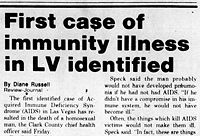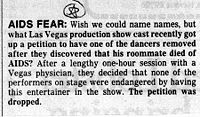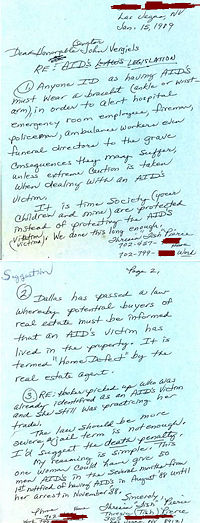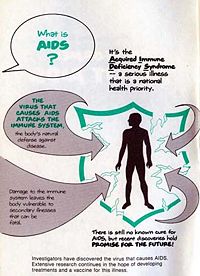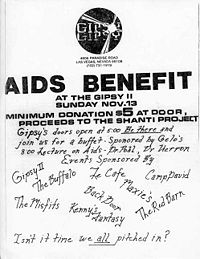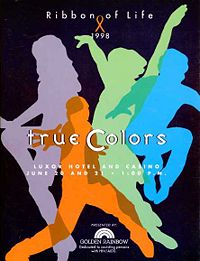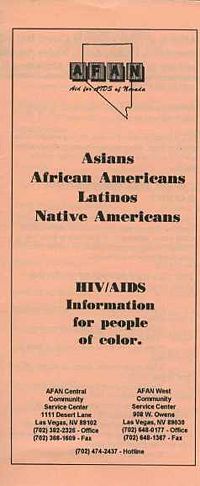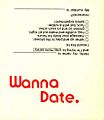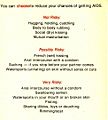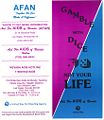Difference between revisions of "AIDS in Southern Nevada"
m |
m |
||
| (7 intermediate revisions by the same user not shown) | |||
| Line 1: | Line 1: | ||
'''AIDS in Southern Nevada''' | '''AIDS in Southern Nevada''' | ||
| + | |||
| + | [[Category:Las Vegas, Nevada]] | ||
| + | [[Category: Nevada]] | ||
| + | [[Category: AIDS]] | ||
| + | [[Category: Organizations]] | ||
| + | |||
(c) Dennis McBride, 2010 | (c) Dennis McBride, 2010 | ||
| − | On March 10, 1983, a 32-year-old man died in Las Vegas of Acquired Immune Deficiency Syndrome [AIDS].<ref name="ref1">''Las Vegas Review-Journal'' (March 12, 1983), 1C; ''Las Vegas Sun'' (March 12, 1983), 11; ''Nevada Gay Times'' (April 1983), 1.</ref>This was Southern Nevada’s first recorded case of the plague that had been sweeping gay communities elsewhere for at least three years. Nevada business and political authorities panicked: with an economy based upon tourism, any negative publicity was disastrous. | + | == AIDS and Las Vegas Tourism == |
| + | On March 10, 1983, a 32-year-old man died in Las Vegas of Acquired Immune Deficiency Syndrome [AIDS].<ref name="ref1">''Las Vegas Review-Journal'' (March 12, 1983), 1C; ''Las Vegas Sun'' (March 12, 1983), 11; ''Nevada Gay Times'' (April 1983), 1.</ref>This was Southern Nevada’s first recorded case of the plague that had been sweeping gay communities elsewhere for at least three years. Nevada business and political authorities panicked: with an economy based upon tourism, any negative publicity was disastrous.[[Image: firstcase1983.jpg|thumb|right|200px|First reported case of AIDS in LV, 1983]] | ||
| + | |||
| − | Nevada’s gay community was taking its first tentative steps out of the closet, gaining recognition through such organizations as Nevadans for Human Rights, the [[Metropolitan Community Church]], and the Gay Academic Union at the University of Nevada, Las Vegas. 1983 marked the first Gay Pride Celebration in the state. It was when AIDS came to Nevada, however, that gay people in the Silver State realized their higher profile made them an inviting target. Citing AIDS, authorities in Nevada shut down the Camp David bath house in Las Vegas — which was one of the few gay venues in the state teaching safe sex and distributing condoms.<ref name="ref2">''Nevada Gay Times'' (August 1983), 12; (April 1984), 3; (May 1984), 1, 6; (July 1985), 4; (August 1985), 1-2; ''Bohemian Bugle'' (December 1985), 1-2; (June 1986), 1-2; (July 1986), 8; (October 1986), 1, 10; ''Las Vegas Bugle'' April 1990), 14; ''Las Vegas Sun'' (June 5, 1985), 1B; (June 7, 1985), 1B; (July 14, 1985), 1B; ''Las Vegas Review-Journal'' (June 6, 1985), 1B; (June 15, 1985), 3B; (June 20, 1985), 6B; (June 5, 1986), 3B; ''Los Angeles Times'' (October 8, 1984), section 1:1, 30-31; Complaint, JTJ Corporation vs City of Las Vegas, et. al., May 30, 1985 and Temporary Restraining Order, Case no. A239353, Dept. XV "U", JTJ Corporation vs City of Las Vegas, et. al, May 31, 1985 [University of Nevada, Las Vegas Lied Library Special Collections (hereafter noted as UNLVSC) MS #2000-14]; David Parks, interview by Dennis McBride, February 16 and 21, 2000 [author’s transcript]; Robert “Rob” Schlegel, interview by Dennis McBride, March 9-11 and 21-22, and April 11, 1998 [author’s transcript]; Wes Davis, interview by Dennis McBride, July 13, 2008 [author’s transcript]; Sally MacEachern, interview by Dennis McBride, February 24 and March 11, 2002 [author’s transcript]; Dennis McBride journals April 18, 1982 and May 4, 1983; also see Steve Hogan and Lee Hudson, ''Completely Queer: The Gay and Lesbian Encyclopedia'' (New York, NY: Henry Holt & Company, 1998), 72-74, 658.</ref> An attempt to open a gay resort in Las Vegas — the Pacifica Hotel—was thwarted over concerns gay tourism would spread AIDS.<ref name="ref3">''Vegas Gay Times'' (October 1979), 5; (November 1979), 9; (February 1980), 3; ''Nevada Action'' (February 1980), 23; (July 1980), 35; (February 1982), 14-15; ''Nevada Gay Times'' (August 1985), 4; ''[California] Data-Boy'' (August 1, 1985), 44-45; ''Vegas Visitor'' (August 16, 1985), 23; ''Las Vegas Review-Journal'' (July 10, 1985), 1A; (July 11, 1985), 1B, 6B; (July 19, 1985), 5B; (July 21, 1985), 4A; (July 24, 1985), 7B; (July 25, 1985), 1B, 8B; (July 26, 1985), 1B, 6B; (August 21, 1985), 2B; (October 5, 1985), 1B, 8B; (November 1, 1985), 3B; (February 18, 1986), 1B, 5B; (October 2, 1986), 3B;(October 22, 1986), 2B; ''Las Vegas Sun'' (July 9, 1985), 1B; (July 10, 1985), 1B, 4B; (July 11, 1985), 1B-2B; (July 22, 1985), 6B; (August 20, 1985), 1A, 5A; (November 1, 1985), 3B; (October 3, 1986), 2B; (October 22, 1986), 1A; UNLVSC MS #85-121; Christie Young, interview by Dennis McBride, October 18, 1998 [UNLVSC HQ76.2 U52 N359 1998]; Judy Corbisiero, interview by Dennis McBride, September 5, 2003; May 21, July 2, and December 10, 2004 [author’s transcript]; Robert “Rob” Schlegel.</ref> The [[Reno Gay Rodeo (RGR)]] — perhaps the most positive public relations tool for the gay community—was shut down over concerns about AIDS.<ref name="ref4"> Nevada Gay Rodeo Association Gymkhana '94 program (insert in ''Las Vegas Bugle'' [June 1984]); rental agreements between Silver State Gay Rodeo Association and Lawlor Events Center, October 28, 1987 and April 18, 1988 [UNLVSC MS #2005-08]; Bohemian Bugle (September 1988), 1; (October 1988 special edition), 1-2; (October 1988), 1, 17, 19; ''Reno Gazette-Journal'' (September 3, 1988), 1C; (September 7, 1988), 1C; (September 16, 1988), 2C; (September 17, 1988), 2C; (September 20, 1988), 1C; (September 21, 1988), 1C; (September 22, 1988), 1C-2C; (September 25, 1988), 2C; (October 1, 1988), 1C; (October 7, 1988), 1C-2C; (October 17, 1988), 1C-2C; (October 20, 1988), 1C, 16C; (October 21, 1988), p. 1C; (October 22, 1988), 1A, 10A; Edward “Eddie” Anderson, interview by Dennis McBride, October 11-14, 2000 [author’s transcript].</ref> And it was AIDS hysteria that helped end attempts to establish a gay town in Nevada called [[Stonewall Park]].<ref name="ref5">Dennis McBride, “Stonewall Park,” ''Nevada Historical Society Quarterly'', v. 52:2 [Summer 2009], 109-46; ''Advocate'' (October 14, 1986), 10-11, 20; ''Los Angeles Times'' (February 15, 1987), part 6, pp. 1, 8.</ref>AIDS devastated the state’s entertainment and service industries: dancers, choreographers, designers, costumers, waiters, chefs, musicians, and singers died of AIDS by the hundreds, while paranoia in the showrooms of Las Vegas led hotels to expose and fire gay employees.<ref name="ref6">''Las Vegas Sun'' (September 27, 1985), 1C; (February 8, 1988), 1A, 4A; (February 10, 1988), 6B; ''Las Vegas Review-Journal'' (March 10, 1991), 15; ''LV: The Magazine of Las Vegas'' (January 1986), 68-69; Jerry Cade, interview by Dennis McBride, February 8, May 17, June 21, July 26, November 1 and 22, 2003 [author’s transcript]; Mike Mas, interview by Dennis McBride, March 6, 1998 [UNLVSC HQ76.2 U52 N363 1997]; Marge Jacques, interview by Dennis McBride, May 26 and 28, 1998 [author’s transcript]; MacEachern; Davis; Robert “Rob” Schlegel.</ref> Such staple Nevada entertainers as Liberace and Wayland Flowers died of AIDS, and so did influential entertainment columnist Dick Maurice.<ref name="ref7">''Las Vegas Review-Journal'' (February 5, 1987), 1A; (October 8, 1988), 1B; (November 10, 1989), 8C; ''Las Vegas Sun'' (January 24, 1987), 1A; (February 5, 1987), 1A; (November 10, 1989), 1A; ''Bohemian Bugle'' (February 1987), 1, 8.</ref> | + | Nevada’s gay community was taking its first tentative steps out of the closet, gaining recognition through such organizations as Nevadans for Human Rights, the [[Metropolitan Community Church]], and the Gay Academic Union at the University of Nevada, Las Vegas. 1983 marked the first Gay Pride Celebration in the state. It was when AIDS came to Nevada, however, that gay people in the Silver State realized their higher profile made them an inviting target. Citing AIDS, authorities in Nevada shut down the Camp David bath house in Las Vegas — which was one of the few gay venues in the state teaching safe sex and distributing condoms.<ref name="ref2">''Nevada Gay Times'' (August 1983), 12; (April 1984), 3; (May 1984), 1, 6; (July 1985), 4; (August 1985), 1-2; ''Bohemian Bugle'' (December 1985), 1-2; (June 1986), 1-2; (July 1986), 8; (October 1986), 1, 10; ''Las Vegas Bugle'' April 1990), 14; ''Las Vegas Sun'' (June 5, 1985), 1B; (June 7, 1985), 1B; (July 14, 1985), 1B; ''Las Vegas Review-Journal'' (June 6, 1985), 1B; (June 15, 1985), 3B; (June 20, 1985), 6B; (June 5, 1986), 3B; ''Los Angeles Times'' (October 8, 1984), section 1:1, 30-31; Complaint, JTJ Corporation vs City of Las Vegas, et. al., May 30, 1985 and Temporary Restraining Order, Case no. A239353, Dept. XV "U", JTJ Corporation vs City of Las Vegas, et. al, May 31, 1985 [University of Nevada, Las Vegas Lied Library Special Collections (hereafter noted as UNLVSC) MS #2000-14]; David Parks, interview by Dennis McBride, February 16 and 21, 2000 [author’s transcript]; Robert “Rob” Schlegel, interview by Dennis McBride, March 9-11 and 21-22, and April 11, 1998 [author’s transcript]; Wes Davis, interview by Dennis McBride, July 13, 2008 [author’s transcript]; Sally MacEachern, interview by Dennis McBride, February 24 and March 11, 2002 [author’s transcript]; Dennis McBride journals April 18, 1982 and May 4, 1983; also see Steve Hogan and Lee Hudson, ''Completely Queer: The Gay and Lesbian Encyclopedia'' (New York, NY: Henry Holt & Company, 1998), 72-74, 658.</ref> An attempt to open a gay resort in Las Vegas — the Pacifica Hotel—was thwarted over concerns gay tourism would spread AIDS.<ref name="ref3">''Vegas Gay Times'' (October 1979), 5; (November 1979), 9; (February 1980), 3; ''Nevada Action'' (February 1980), 23; (July 1980), 35; (February 1982), 14-15; ''Nevada Gay Times'' (August 1985), 4; ''[California] Data-Boy'' (August 1, 1985), 44-45; ''Vegas Visitor'' (August 16, 1985), 23; ''Las Vegas Review-Journal'' (July 10, 1985), 1A; (July 11, 1985), 1B, 6B; (July 19, 1985), 5B; (July 21, 1985), 4A; (July 24, 1985), 7B; (July 25, 1985), 1B, 8B; (July 26, 1985), 1B, 6B; (August 21, 1985), 2B; (October 5, 1985), 1B, 8B; (November 1, 1985), 3B; (February 18, 1986), 1B, 5B; (October 2, 1986), 3B;(October 22, 1986), 2B; ''Las Vegas Sun'' (July 9, 1985), 1B; (July 10, 1985), 1B, 4B; (July 11, 1985), 1B-2B; (July 22, 1985), 6B; (August 20, 1985), 1A, 5A; (November 1, 1985), 3B; (October 3, 1986), 2B; (October 22, 1986), 1A; UNLVSC MS #85-121; Christie Young, interview by Dennis McBride, October 18, 1998 [UNLVSC HQ76.2 U52 N359 1998]; Judy Corbisiero, interview by Dennis McBride, September 5, 2003; May 21, July 2, and December 10, 2004 [author’s transcript]; Robert “Rob” Schlegel.</ref> The [[Reno Gay Rodeo (RGR)]] — perhaps the most positive public relations tool for the gay community—was shut down over concerns about AIDS.<ref name="ref4"> Nevada Gay Rodeo Association Gymkhana '94 program (insert in ''Las Vegas Bugle'' [June 1984]); rental agreements between Silver State Gay Rodeo Association and Lawlor Events Center, October 28, 1987 and April 18, 1988 [UNLVSC MS #2005-08]; ''Bohemian Bugle'' (September 1988), 1; (October 1988 special edition), 1-2; (October 1988), 1, 17, 19; ''Reno Gazette-Journal'' (September 3, 1988), 1C; (September 7, 1988), 1C; (September 16, 1988), 2C; (September 17, 1988), 2C; (September 20, 1988), 1C; (September 21, 1988), 1C; (September 22, 1988), 1C-2C; (September 25, 1988), 2C; (October 1, 1988), 1C; (October 7, 1988), 1C-2C; (October 17, 1988), 1C-2C; (October 20, 1988), 1C, 16C; (October 21, 1988), p. 1C; (October 22, 1988), 1A, 10A; Edward “Eddie” Anderson, interview by Dennis McBride, October 11-14, 2000 [author’s transcript].</ref> And it was AIDS hysteria that helped end attempts to establish a gay town in Nevada called [[Stonewall Park]].<ref name="ref5">Dennis McBride, “Stonewall Park,” ''Nevada Historical Society Quarterly'', v. 52:2 [Summer 2009], 109-46; ''Advocate'' (October 14, 1986), 10-11, 20; ''Los Angeles Times'' (February 15, 1987), part 6, pp. 1, 8.</ref>AIDS devastated the state’s entertainment and service industries: dancers, choreographers, designers, costumers, waiters, chefs, musicians, and singers died of AIDS by the hundreds, while paranoia in the showrooms of Las Vegas led hotels to expose and fire gay employees.<ref name="ref6">''Las Vegas Sun'' (September 27, 1985), 1C; (February 8, 1988), 1A, 4A; (February 10, 1988), 6B; ''Las Vegas Review-Journal'' (March 10, 1991), 15; ''LV: The Magazine of Las Vegas'' (January 1986), 68-69; Jerry Cade, interview by Dennis McBride, February 8, May 17, June 21, July 26, November 1 and 22, 2003 [author’s transcript]; Mike Mas, interview by Dennis McBride, March 6, 1998 [UNLVSC HQ76.2 U52 N363 1997]; Marge Jacques, interview by Dennis McBride, May 26 and 28, 1998 [author’s transcript]; MacEachern; Davis; Robert “Rob” Schlegel.</ref> Such staple Nevada entertainers as Liberace and Wayland Flowers died of AIDS, and so did influential entertainment columnist Dick Maurice.<ref name="ref7">''Las Vegas Review-Journal'' (February 5, 1987), 1A; (October 8, 1988), 1B; (November 10, 1989), 8C; ''Las Vegas Sun'' (January 24, 1987), 1A; (February 5, 1987), 1A; (November 10, 1989), 1A; ''Bohemian Bugle'' (February 1987), 1, 8.</ref>[[Image: petition1985.jpg|thumb|left|200px|Petition, 1985]] |
| − | Voices of reason were few, but loud. The ''Las Vegas Review-Journal'' published an article titled, "Fear of AIDS Making Gays Victims of Prejudice," noting that, "Instead of showing sensitivity in the face of a terrible disease, homophobia and open prejudice are once again the norm."<ref name="ref8">''Las Vegas Review-Journal'' (July 24, 1983), 1B, 4B.</ref> ''Las Vegas Sun'' columnist Muriel Stevens wrote, "Without question it is the gay community who will suffer most from the doubt and fear that is sweeping our country. ... They worry about their heterosexual friends cutting them off. They worry about their jobs and about being ostracized by neighbors and co-workers."<ref name="ref9">''Las Vegas Sun'' (September 20, 1985), 1F.</ref> | + | [[Image: pierceletter1989.jpg|thumb|left|200px|Letter to a legislator, 1989]]Voices of reason were few, but loud. The ''Las Vegas Review-Journal'' published an article titled, "Fear of AIDS Making Gays Victims of Prejudice," noting that, "Instead of showing sensitivity in the face of a terrible disease, homophobia and open prejudice are once again the norm."<ref name="ref8">''Las Vegas Review-Journal'' (July 24, 1983), 1B, 4B.</ref> ''Las Vegas Sun'' columnist Muriel Stevens wrote, "Without question it is the gay community who will suffer most from the doubt and fear that is sweeping our country. ... They worry about their heterosexual friends cutting them off. They worry about their jobs and about being ostracized by neighbors and co-workers."<ref name="ref9">''Las Vegas Sun'' (September 20, 1985), 1F.</ref> |
| + | == Pillars of the Community == | ||
Nevada’s gay community had to depend upon itself when it was clear the legal and medical establishment wasn’t going to be much help in fighting AIDS. To that end, the 1980s and ‘90s saw a number of organizations and events established to deal with the disease, many of which remain today as pillars of the community. | Nevada’s gay community had to depend upon itself when it was clear the legal and medical establishment wasn’t going to be much help in fighting AIDS. To that end, the 1980s and ‘90s saw a number of organizations and events established to deal with the disease, many of which remain today as pillars of the community. | ||
| − | The first of these was Aid for AIDS of Nevada [AFAN], named for the California organization which inspired it, founded in March 1984 by people representing the spectrum of the Las Vegas gay community: Rev. Rusty Carlson of MCC-Las Vegas; Wes Davis, manager of the popular Buffalo bar; Terry Wilsey and his lover, Dr. Walt Herron, representing [[Nevadans for Human Rights]], the ''Gay Switchboard'', and the ''Nevada Gay Times''; the Lesbian Gay Academic Union [LGAU] at the University of Nevada, Las Vegas; the Community Action Committee [publishers of ''Desert Gaze'']; Rick Reich from the Southern Nevada Health District; and Rob Schlegel, future publisher of the ''Las Vegas Bugle'', and one of the community’s greatest activists. AFAN still exists today as one of the most respected institutions in the Nevada gay community. The Las Vegas AIDS Walk founded by AFAN in 1991 continues as one of the city’s premier fund-raising events.<ref name="ref10">''Desert Gaze'' (April 1984), 6; ''Nevada Gay Times'' (April 1984), insert, 11; (May 1984), 15; (June 1984), 9; Bohemian Bugle (December 1985), 6; (February 1988), 12; ''Las Vegas Bugle'' (April 1991), 14; ''AFAN News'' (May/June 1991), 1, 8-9; ''Las Vegas Sun'' (May 8, 1991), 11C; (May 13, 1991), 1E; ''Las Vegas Review-Journal'' (May 12, 1991), 10J; (May 17, 1991), 17E; (May 19, 1991), 16B ; Kevin Kelly, interview by Dennis McBride, September 8, 22, and November 10, 2000 [author’s transcript]; Davis; Mas; Robert “Rob” Schlegel; Cade; Parks; MacEachern.</ref> | + | The first of these was Aid for AIDS of Nevada [AFAN], named for the California organization which inspired it, founded in March 1984 by people representing the spectrum of the Las Vegas gay community: Rev. Rusty Carlson of MCC-Las Vegas; Wes Davis, manager of the popular Buffalo bar; Terry Wilsey and his lover, Dr. Walt Herron, representing [[Nevadans for Human Rights]], the ''Gay Switchboard'', and the ''Nevada Gay Times''; the Lesbian Gay Academic Union [LGAU] at the University of Nevada, Las Vegas; the Community Action Committee [publishers of ''Desert Gaze'']; Rick Reich from the Southern Nevada Health District; and Rob Schlegel, future publisher of the ''Las Vegas Bugle'', and one of the community’s greatest activists. AFAN still exists today as one of the most respected institutions in the Nevada gay community. The Las Vegas AIDS Walk founded by AFAN in 1991 continues as one of the city’s premier fund-raising events.<ref name="ref10">''Desert Gaze'' (April 1984), 6; ''Nevada Gay Times'' (April 1984), insert, 11; (May 1984), 15; (June 1984), 9; ''Bohemian Bugle'' (December 1985), 6; (February 1988), 12; ''Las Vegas Bugle'' (April 1991), 14; ''AFAN News'' (May/June 1991), 1, 8-9; ''Las Vegas Sun'' (May 8, 1991), 11C; (May 13, 1991), 1E; ''Las Vegas Review-Journal'' (May 12, 1991), 10J; (May 17, 1991), 17E; (May 19, 1991), 16B ; Kevin Kelly, interview by Dennis McBride, September 8, 22, and November 10, 2000 [author’s transcript]; Davis; Mas; Robert “Rob” Schlegel; Cade; Parks; MacEachern.</ref> |
| + | |||
| + | [[Image: aidsbrochure1984.jpg|thumb|right|200px|AIDS Brochure, 1984]]Many other community organizations sprang up in the absence of local government help. The most notable of these included the Las Vegas Task Force on AIDS [1985]; the Generic Black & White Party [1986]; the Nevada AIDS Project, founded in 1987 by lovers Lisa Hernandez and Kathleen Stubblefield; and the NAMES Project, which produced Nevada panels for the national AIDS Quilt.<ref name="ref11">''Nevada Gay Times'' (October 1985), 7, 12; ''Bohemian Bugle'' (November 1985), 5; (January 1986), 9; (March 1987), 21; ''Las Vegas Bugle'' (December 1989), 15; (January 1990), 1; (February 1990), 4, 21; (March 1990), 1, 13; (May 1990), 23; (September/October 1990), 4; (October/November 1990), 19; (November/December 1990), 15-17; (August 1991), 1; (September 1991), 9, 21; (October 1991), 24; (November 1991), 2; (April/May 1992), 6; (August 1992), 14-15; (November 1992), 26; (April/May 1993), 30; (July/August 1993), 17, 26; (August/September 1993), 13, 17-18; (September/October 1993), 13-14, 28, 38; (February 1994), 12; (March 1994), 5; (September/October 1994), 25; (December 1995), 23; (June/July 1996), 26-3; (September 1998), 5-7; (August 13,1999), 24; (September 10, 1999), 39-40; (September 24, 1999), 38-41; ''Lesbian Voice'' (September 2001), 22-24, 26; ''Out Las Vegas'' (August 2001), 16,19; ''Las Vegas Sun'' (November 23, 1989), 8B; (August 12, 1996), 1E-2E; ''Las Vegas Review-Journal'' (February 26, 1987), 1C; (August 19, 1997), 4E; ''Night Beat'' (September 1993), 8; UNLVSC MS #85-121; Marlon Tinana/Ed Uehling, interview by Dennis McBride, March 14, 21, 22, 2000 [author’s transcript]; Anne Davis Mulford, interview by Dennis McBride, June 7 and July 22, 2002 [author’s transcript]; Cade; Robert “Rob” Schlegel; Davis.</ref> ACT-UP! Nevada [AIDS Coalition to Unleash Power] was founded in 1990 by Arne Frazin and staged at least seven demonstrations before ending in 1995 when Frazin died.<ref name="ref12">''Las Vegas Bugle'' (September/October 1990), 18; (October/November 1990), 13; (November/December 1990), 26; (December 1990), 1, 19; (February 1991), 13; (August 1994), 50; (November/December 1994), 22-23; (December 1994/January 1995), 46-47; (March/April 1995), 33; (December 1995), 56-57; ''Las Vegas Review-Journal'' (December 8, 1990), 1A, 4A; (December 13, 1990), 14B; (June 21, 1994), 3B; ''Las Vegas Sun'' (December 11, 1990), 11A; (December 12, 1990), 6A.</ref> LUCES de Las Vegas [Latinos Unidos Contra El SIDA], established in 1999, served the Latino community in Las Vegas, while three other services—FACT [Fighting AIDS in Our Community Today], Sista to Sista, and AFAN's West Community Service Center in Nucleus Plaza supported Las Vegas's African-American community. By 1992, while blacks made up 10% of Clark County's population, they were 17% of the county's AIDS patients.<ref name="ref13">''Las Vegas Sun'' (July 14, 1999), 1B, 5B; (July 26, 1999), 1B, 3B; (March 5, 2002), 5B; (July 2, 2003), 7B; (July 23, 2003), 7A; (July 26, 2004), 3B; ''Las Vegas Review-Journal'' (July 26, 1992), 1B, 9; (October 13, 2001), 14B; (May 19, 2002), 1J, 6J; (November 2, 2002), 1B, 7B; (July 8, 2003), 1B, 5B; (July 26, 2003), 14B; (April 24, 2004), 2B; (August 28, 2004), 2B; ''Las Vegas Bugle'' (August 1991), 18; (October 1992), 51; (October 10, 2001), 8, 15; (August 1, 2003), 15-17; ''Las Vegas CityLife'' (July 31, 2003), 10; (August 7, 2003), 17; (April 29, 2004), 10; Cade.</ref> In July 1998 the Catholic diocese of Las Vegas brought Father Joseph O'Brien from Phoenix to build an AIDS ministry associated with the church. The St. Therese Center—named for St. Therese of Lisieux—opened offices in Henderson, Nevada on October 19, 1998.<ref name="ref14">''Las Vegas Review-Journal'' (November 26, 1998), 1B, 5B; (August 19, 2001), 3J; (May 19, 2002), 1J, 6J; (December 25, 2005), 3J; ''Las Vegas Sun'' (August 26, 2004), 19A; ''Boulder City News'' (December 9, 1999), 17; ''Las Vegas Bugle'' (October 13, 2000), 42; (August 3, 2001), 23; (February 14, 2004), 32-35; ''Las Vegas CityLife'' (September 13, 2001), 12-13; ''Night Beat'' (August 2004), 15; Cade.</ref> | ||
| + | |||
| + | |||
| + | == Networks of Support and Fundraisers == | ||
| + | [[Image: firstbenefit1983.jpg|thumb|left|200px|First community AIDS benefit, 1983]]The first major AIDS fundraiser in Nevada was the Superstar Aid for AIDS Benefit performed in the Cafe Continental Theatre at the Stardust Hotel on June 14, 1987. Coordinated for AFAN by entertainment writer Esther Lynn, the Superstar Benefit brought talent from all over the Las Vegas Strip and set the standard for all such fund-raisers that followed. It took several months, however, for Lynn to find a hotel willing to allow an AIDS event in its showroom.<ref name="ref15">''Bohemian Bugle'' (May 1987), 16; (June 1987), 1, 5, 6; (July 1987), 4; ''Las Vegas Review-Journal'' (June 7, 1987), 7B; (June 12, 1987), 2E, 18E; ''Las Vegas Sun'' (May 4, 1987), 5D; (May 20, 1987), 7D; (June 12, 1987), 2D; (June 16, 1987), 6B; (June 20, 1987), 8L; ''Advocate'' (June 9, 1987), 26; Esther Lynn, interview by Dennis McBride, August 24, 2000 [author’s transcript]; Parks; Davis.</ref> Just a month later, Golden Rainbow, an organization founded to produce star-studded AIDS fundraising events for Las Vegas’s hard-hit entertainment community, performed its first show. Golden Rainbow, named after a popular 1968 Broadway musical, was the brainchild of singer Bree Burgess and Bally’s Hotel credit union manager Peter Todd. The organization was founded in response to the 1986 AIDS death of popular Las Vegas entertainer Chris Carter; Carter died alone on a cot in his brother’s garage because his family wouldn’t allow him in the house. Golden Rainbow remains today one of the most successful AIDS organizations in the nation.<ref name="ref16">''Bohemian Bugle'' (July 1987), 1, 9, 16; (August 1987), 13; (December 1987), 17; (March 1988), 23; ''Las Vegas Bugle'' (March 1991), 26-28, 30; ''Las Vegas Review-Journal'' (November 27, 1988), 1B, 3B; (March 10, 1991), 1J, 4J; Golden Rainbow of Nevada, Inc. incorporation papers, December 1, 1987 [UNLVSC MS #2006-21]; Lee Plotkin, interview by Dennis McBride, August 2, 10, 16 and October 4, 2006 [author’s transcript]; Davis; Cade.</ref> [[Image: truerainbow1998.jpg|thumb|right|200px|Golden Rainbow, 1998]] | ||
| + | |||
| + | Perhaps the most important response to AIDS in Southern Nevada, however, was the dedicated AIDS services provided at the University Medical Center [UMC] in Las Vegas, the city’s only public hospital, by gay physicians Jerry Cade and Mel Pohl, with the support of the Southern Nevada Health District through its communicable disease investigator and AIDS coordinator, Rick Reich. | ||
| + | |||
| + | [[Image: afanbroch1993.jpg|thumb|left|200px|AFAN brochure,1993]]Las Vegas’s private medical establishment was reluctant to treat AIDS patients because most of those afflicted with the disease had lost their jobs, been abandoned by friends and family, and had no money or insurance. Further, physicians who had spent heavily to finance their education and practice didn’t want to risk becoming known as “AIDS doctors,” or that they had AIDS patients in their waiting room—and these included gay doctors who had a vested interest in treating their community. By the mid-1980s, 90% of southern Nevada’s AIDS patients were being treated by Drs. Mel Pohl and Jerry Cade, who, on August 29, 1985, set up an unofficial AIDS inpatient unit at UMC, with a group of 10 nurses who had long been agitating to work with AIDS patients. While UMC could provide hospitalization, there were no outpatient resources for people who only needed testing, diagnosis and other medical requirements. These were provided solely—and at their own expense--by Cade and Pohl in their small office on Charleston Boulevard.<ref name="ref17">''Nevada Gay Times'' (April 1983), 6, 14; (May 1983), 4; (July 1983), 5, 8; ''Bohemian Bugle'' (December 1986), 6; (January 1988), 1, 27; ''Las Vegas Review-Journal'' (July 24, 1983), 1B, 4B; ''Las Vegas Review-Journal'' “Nevadan” (August 30, 1987), cover, 3-7; Mel Pohl, interview by Dennis McBride, December 20, 2008 [author’s transcript]; Parks; Robert “Rob” Schlegel; Cade.</ref> | ||
| + | |||
| + | Pohl and Cade approached UMC about establishing an outpatient clinic, and in 1986, when AZT [azidothymidine] was first tested as an HIV treatment, Rick Reich, together with District health officer Otto Ravenholt and Evelyn McColl, director of the county’s clinics and nursing services, convinced the Clark County Commissioners—who managed UMC--to set up a dedicated outpatient clinic. The first dose of AZT available in Nevada was dispensed in this new outpatient clinic on December 29, 1986 to a patient known only as “Scott.”<ref name="ref18">''Las Vegas Review-Journal'' (September 25, 1986), 4B; (October 2, 1986), 2B; (December 30, 1986), 1B-2B; (August 30, 1987), 1A, 4A; (October 23, 1989), 1B-2B; ''Las Vegas Sun'' (September 27, 1986), 6B; (December 30, 1986), 2B; ''Bohemian Bugle'' (October 1986), 1, 4; (December 1986), 8, 18; Cade.</ref> Six months later, on July 6, 1987, UMC’s unofficial AIDS inpatient unit became official, opening in a newly remodeled section of the hospital known as 1 Southwest, and the outpatient clinic was integrated into it. Las Vegas became the only city in the nation with a population of less than a million with a dedicated AIDS ward.<ref name="ref19">''Las Vegas Review-Journal'' (July 6, 1987), 1B; ''Las Vegas Sun'' (July 5, 1987), 1B; (July 11, 1987), 2B; ''Bohemian Bugle'' (July 1987), 1, 20; (October 1987), 18, 23; (May 1988), 13; ''Las Vegas Bugle'' (May/June 1993), 24-26; (November 1993), 19, 31; (December 1993), 37; (September/October 1995), 10-15; (October/November 1995), 27; Cade; cf. ''Las Vegas Review-Journal'' “Nevadan” (August 30, 1987), cover, 3-7.</ref> For several years the inpatient ward and outpatient clinic were operated together, and worked in concert with AFAN, Golden Rainbow, and other AIDS services and organizations. On June 30, 1991, the outpatient clinic moved into a free-standing facility at 1112 Shadow Lane, and in 1994 became known as the UMC Wellness Center. The clinic moved twice more: in 1998 to 2300 Shadow Lane, and in 2008 to 701 Shadow Lane, which was dedicated on December 1—World AIDS Day.<ref name="ref20">''Las Vegas Bugle'' (January 1989), 22; (June 1994), 14-15, 17; (March/April 1995), 53; (August 1998), 22; (November 1998), 11; ''Night Beat'' (August 2004), 14; (January 2009), cover, 20-21; ''AFAN News'' (May/June 1991), 12; (July/August 1991), 15; ''Lesbian Visions of Southern Nevada'' (June 1994), 2, 4; ''Las Vegas Review-Journal'' (May 23, 1994), 1B, 4B; ''Las Vegas Sun'' (July 8, 1998), 8C; Cade.</ref> | ||
| + | |||
| + | Today, with a multitude of drugs and treatment, together with education that began in the queer community, AIDS is no longer the fourth horseman it was in the 1980s. Despite the social and physical scourge the epidemic brought, it also bonded the Nevada gay community in a way only great disaster can do. AIDS forced the gay community to grow, adapt, and mature into the potent political force it became in the 1990s. | ||
| + | |||
| + | ---- | ||
| + | |||
| + | == Image Gallery == | ||
| + | |||
| + | <div style="text-align: center;"> | ||
| + | <gallery> | ||
| + | Image: firstcase1983.jpg|First reported case of AIDS in LV, 1983 | ||
| + | Image: firstbenefit1983.jpg|First community AIDS benefit, 1983 | ||
| + | Image: aidsbrochure1984.jpg|AIDS Brochure, 1984 | ||
| + | Image: afanbroch1993.jpg|AFAN brochure, 1993 | ||
| + | Image: pierceletter1989.jpg|Letter to a legislator, 1989 | ||
| + | Image: truerainbow1998.jpg|Golden Rainbow, 1998 | ||
| + | Image: aidslv02.jpg|''Las Vegas Review-Journal'', July 6, 1983, 5B | ||
| + | Image:aidslv5a.jpg|safe-sex trick card, 1985 - front | ||
| + | Image:aidslv5b.JPG|safe-sex trick card, 1985 - back | ||
| + | Image:aidslv07.JPG|brochure, 1986 | ||
| + | Image:aidslv08.jpg|Superstar Aid for AIDS Benefit, June 14, 1987 | ||
| + | Image:aidslv09.jpg|''Las Vegas Review-Journal'', July 6, 1987, 1B | ||
| + | Image:aidslv10.JPG|AFAN brochure, 1989 | ||
| + | Image:aidslv12.jpg|Golden Rainbow, 1990 | ||
| + | Image:aidslv13.jpg|''Las Vegas Review-Journal'', May 19, 1991, 16B | ||
| + | Image:aidslv14.jpg|Southern Nevada NAMES Project, ca. 1991 | ||
| + | Image:aidslv15.JPG|AIDS hysteria, 1991 | ||
| + | Image:aidslv16.JPG|Southern Nevada AIDS Project, 1992 | ||
| + | Image:aidslv18.jpg|ACT UP, Nevada protest, June 20, 1994 | ||
| + | Image:aidslv19.jpg|brochure, 1996 | ||
| + | Image:aidslv20.jpg|brochure, 1997 | ||
| + | Image:aidslv21.jpg|World AIDS Day, 1997 | ||
| + | Image:aidslv22.jpg|dedication of the Las Vegas AIDS Memorial garden at the University of Nevada, Las Vegas, May 17, 1998 | ||
| + | Image:aidslv24.jpg|St. Therese Center, 1999 | ||
| + | Image:aidslv25.jpg|brochure, 2003 | ||
| + | Image:aidslv26.jpg|Sista to Sista, 2003 | ||
| + | </gallery> | ||
| + | </div> | ||
| + | ---- | ||
| − | + | ==Notes== | |
| + | <references/> | ||
Latest revision as of 14:52, 24 March 2010
AIDS in Southern Nevada
(c) Dennis McBride, 2010
AIDS and Las Vegas Tourism
On March 10, 1983, a 32-year-old man died in Las Vegas of Acquired Immune Deficiency Syndrome [AIDS].[1]This was Southern Nevada’s first recorded case of the plague that had been sweeping gay communities elsewhere for at least three years. Nevada business and political authorities panicked: with an economy based upon tourism, any negative publicity was disastrous.
Nevada’s gay community was taking its first tentative steps out of the closet, gaining recognition through such organizations as Nevadans for Human Rights, the Metropolitan Community Church, and the Gay Academic Union at the University of Nevada, Las Vegas. 1983 marked the first Gay Pride Celebration in the state. It was when AIDS came to Nevada, however, that gay people in the Silver State realized their higher profile made them an inviting target. Citing AIDS, authorities in Nevada shut down the Camp David bath house in Las Vegas — which was one of the few gay venues in the state teaching safe sex and distributing condoms.[2] An attempt to open a gay resort in Las Vegas — the Pacifica Hotel—was thwarted over concerns gay tourism would spread AIDS.[3] The Reno Gay Rodeo (RGR) — perhaps the most positive public relations tool for the gay community—was shut down over concerns about AIDS.[4] And it was AIDS hysteria that helped end attempts to establish a gay town in Nevada called Stonewall Park.[5]AIDS devastated the state’s entertainment and service industries: dancers, choreographers, designers, costumers, waiters, chefs, musicians, and singers died of AIDS by the hundreds, while paranoia in the showrooms of Las Vegas led hotels to expose and fire gay employees.[6] Such staple Nevada entertainers as Liberace and Wayland Flowers died of AIDS, and so did influential entertainment columnist Dick Maurice.[7]
Voices of reason were few, but loud. The Las Vegas Review-Journal published an article titled, "Fear of AIDS Making Gays Victims of Prejudice," noting that, "Instead of showing sensitivity in the face of a terrible disease, homophobia and open prejudice are once again the norm."[8] Las Vegas Sun columnist Muriel Stevens wrote, "Without question it is the gay community who will suffer most from the doubt and fear that is sweeping our country. ... They worry about their heterosexual friends cutting them off. They worry about their jobs and about being ostracized by neighbors and co-workers."[9]
Pillars of the Community
Nevada’s gay community had to depend upon itself when it was clear the legal and medical establishment wasn’t going to be much help in fighting AIDS. To that end, the 1980s and ‘90s saw a number of organizations and events established to deal with the disease, many of which remain today as pillars of the community.
The first of these was Aid for AIDS of Nevada [AFAN], named for the California organization which inspired it, founded in March 1984 by people representing the spectrum of the Las Vegas gay community: Rev. Rusty Carlson of MCC-Las Vegas; Wes Davis, manager of the popular Buffalo bar; Terry Wilsey and his lover, Dr. Walt Herron, representing Nevadans for Human Rights, the Gay Switchboard, and the Nevada Gay Times; the Lesbian Gay Academic Union [LGAU] at the University of Nevada, Las Vegas; the Community Action Committee [publishers of Desert Gaze]; Rick Reich from the Southern Nevada Health District; and Rob Schlegel, future publisher of the Las Vegas Bugle, and one of the community’s greatest activists. AFAN still exists today as one of the most respected institutions in the Nevada gay community. The Las Vegas AIDS Walk founded by AFAN in 1991 continues as one of the city’s premier fund-raising events.[10]
Many other community organizations sprang up in the absence of local government help. The most notable of these included the Las Vegas Task Force on AIDS [1985]; the Generic Black & White Party [1986]; the Nevada AIDS Project, founded in 1987 by lovers Lisa Hernandez and Kathleen Stubblefield; and the NAMES Project, which produced Nevada panels for the national AIDS Quilt.[11] ACT-UP! Nevada [AIDS Coalition to Unleash Power] was founded in 1990 by Arne Frazin and staged at least seven demonstrations before ending in 1995 when Frazin died.[12] LUCES de Las Vegas [Latinos Unidos Contra El SIDA], established in 1999, served the Latino community in Las Vegas, while three other services—FACT [Fighting AIDS in Our Community Today], Sista to Sista, and AFAN's West Community Service Center in Nucleus Plaza supported Las Vegas's African-American community. By 1992, while blacks made up 10% of Clark County's population, they were 17% of the county's AIDS patients.[13] In July 1998 the Catholic diocese of Las Vegas brought Father Joseph O'Brien from Phoenix to build an AIDS ministry associated with the church. The St. Therese Center—named for St. Therese of Lisieux—opened offices in Henderson, Nevada on October 19, 1998.[14]
Networks of Support and Fundraisers
The first major AIDS fundraiser in Nevada was the Superstar Aid for AIDS Benefit performed in the Cafe Continental Theatre at the Stardust Hotel on June 14, 1987. Coordinated for AFAN by entertainment writer Esther Lynn, the Superstar Benefit brought talent from all over the Las Vegas Strip and set the standard for all such fund-raisers that followed. It took several months, however, for Lynn to find a hotel willing to allow an AIDS event in its showroom.[15] Just a month later, Golden Rainbow, an organization founded to produce star-studded AIDS fundraising events for Las Vegas’s hard-hit entertainment community, performed its first show. Golden Rainbow, named after a popular 1968 Broadway musical, was the brainchild of singer Bree Burgess and Bally’s Hotel credit union manager Peter Todd. The organization was founded in response to the 1986 AIDS death of popular Las Vegas entertainer Chris Carter; Carter died alone on a cot in his brother’s garage because his family wouldn’t allow him in the house. Golden Rainbow remains today one of the most successful AIDS organizations in the nation.[16]
Perhaps the most important response to AIDS in Southern Nevada, however, was the dedicated AIDS services provided at the University Medical Center [UMC] in Las Vegas, the city’s only public hospital, by gay physicians Jerry Cade and Mel Pohl, with the support of the Southern Nevada Health District through its communicable disease investigator and AIDS coordinator, Rick Reich.
Las Vegas’s private medical establishment was reluctant to treat AIDS patients because most of those afflicted with the disease had lost their jobs, been abandoned by friends and family, and had no money or insurance. Further, physicians who had spent heavily to finance their education and practice didn’t want to risk becoming known as “AIDS doctors,” or that they had AIDS patients in their waiting room—and these included gay doctors who had a vested interest in treating their community. By the mid-1980s, 90% of southern Nevada’s AIDS patients were being treated by Drs. Mel Pohl and Jerry Cade, who, on August 29, 1985, set up an unofficial AIDS inpatient unit at UMC, with a group of 10 nurses who had long been agitating to work with AIDS patients. While UMC could provide hospitalization, there were no outpatient resources for people who only needed testing, diagnosis and other medical requirements. These were provided solely—and at their own expense--by Cade and Pohl in their small office on Charleston Boulevard.[17]
Pohl and Cade approached UMC about establishing an outpatient clinic, and in 1986, when AZT [azidothymidine] was first tested as an HIV treatment, Rick Reich, together with District health officer Otto Ravenholt and Evelyn McColl, director of the county’s clinics and nursing services, convinced the Clark County Commissioners—who managed UMC--to set up a dedicated outpatient clinic. The first dose of AZT available in Nevada was dispensed in this new outpatient clinic on December 29, 1986 to a patient known only as “Scott.”[18] Six months later, on July 6, 1987, UMC’s unofficial AIDS inpatient unit became official, opening in a newly remodeled section of the hospital known as 1 Southwest, and the outpatient clinic was integrated into it. Las Vegas became the only city in the nation with a population of less than a million with a dedicated AIDS ward.[19] For several years the inpatient ward and outpatient clinic were operated together, and worked in concert with AFAN, Golden Rainbow, and other AIDS services and organizations. On June 30, 1991, the outpatient clinic moved into a free-standing facility at 1112 Shadow Lane, and in 1994 became known as the UMC Wellness Center. The clinic moved twice more: in 1998 to 2300 Shadow Lane, and in 2008 to 701 Shadow Lane, which was dedicated on December 1—World AIDS Day.[20]
Today, with a multitude of drugs and treatment, together with education that began in the queer community, AIDS is no longer the fourth horseman it was in the 1980s. Despite the social and physical scourge the epidemic brought, it also bonded the Nevada gay community in a way only great disaster can do. AIDS forced the gay community to grow, adapt, and mature into the potent political force it became in the 1990s.
Image Gallery
Notes
- ↑ Las Vegas Review-Journal (March 12, 1983), 1C; Las Vegas Sun (March 12, 1983), 11; Nevada Gay Times (April 1983), 1.
- ↑ Nevada Gay Times (August 1983), 12; (April 1984), 3; (May 1984), 1, 6; (July 1985), 4; (August 1985), 1-2; Bohemian Bugle (December 1985), 1-2; (June 1986), 1-2; (July 1986), 8; (October 1986), 1, 10; Las Vegas Bugle April 1990), 14; Las Vegas Sun (June 5, 1985), 1B; (June 7, 1985), 1B; (July 14, 1985), 1B; Las Vegas Review-Journal (June 6, 1985), 1B; (June 15, 1985), 3B; (June 20, 1985), 6B; (June 5, 1986), 3B; Los Angeles Times (October 8, 1984), section 1:1, 30-31; Complaint, JTJ Corporation vs City of Las Vegas, et. al., May 30, 1985 and Temporary Restraining Order, Case no. A239353, Dept. XV "U", JTJ Corporation vs City of Las Vegas, et. al, May 31, 1985 [University of Nevada, Las Vegas Lied Library Special Collections (hereafter noted as UNLVSC) MS #2000-14]; David Parks, interview by Dennis McBride, February 16 and 21, 2000 [author’s transcript]; Robert “Rob” Schlegel, interview by Dennis McBride, March 9-11 and 21-22, and April 11, 1998 [author’s transcript]; Wes Davis, interview by Dennis McBride, July 13, 2008 [author’s transcript]; Sally MacEachern, interview by Dennis McBride, February 24 and March 11, 2002 [author’s transcript]; Dennis McBride journals April 18, 1982 and May 4, 1983; also see Steve Hogan and Lee Hudson, Completely Queer: The Gay and Lesbian Encyclopedia (New York, NY: Henry Holt & Company, 1998), 72-74, 658.
- ↑ Vegas Gay Times (October 1979), 5; (November 1979), 9; (February 1980), 3; Nevada Action (February 1980), 23; (July 1980), 35; (February 1982), 14-15; Nevada Gay Times (August 1985), 4; [California] Data-Boy (August 1, 1985), 44-45; Vegas Visitor (August 16, 1985), 23; Las Vegas Review-Journal (July 10, 1985), 1A; (July 11, 1985), 1B, 6B; (July 19, 1985), 5B; (July 21, 1985), 4A; (July 24, 1985), 7B; (July 25, 1985), 1B, 8B; (July 26, 1985), 1B, 6B; (August 21, 1985), 2B; (October 5, 1985), 1B, 8B; (November 1, 1985), 3B; (February 18, 1986), 1B, 5B; (October 2, 1986), 3B;(October 22, 1986), 2B; Las Vegas Sun (July 9, 1985), 1B; (July 10, 1985), 1B, 4B; (July 11, 1985), 1B-2B; (July 22, 1985), 6B; (August 20, 1985), 1A, 5A; (November 1, 1985), 3B; (October 3, 1986), 2B; (October 22, 1986), 1A; UNLVSC MS #85-121; Christie Young, interview by Dennis McBride, October 18, 1998 [UNLVSC HQ76.2 U52 N359 1998]; Judy Corbisiero, interview by Dennis McBride, September 5, 2003; May 21, July 2, and December 10, 2004 [author’s transcript]; Robert “Rob” Schlegel.
- ↑ Nevada Gay Rodeo Association Gymkhana '94 program (insert in Las Vegas Bugle [June 1984]); rental agreements between Silver State Gay Rodeo Association and Lawlor Events Center, October 28, 1987 and April 18, 1988 [UNLVSC MS #2005-08]; Bohemian Bugle (September 1988), 1; (October 1988 special edition), 1-2; (October 1988), 1, 17, 19; Reno Gazette-Journal (September 3, 1988), 1C; (September 7, 1988), 1C; (September 16, 1988), 2C; (September 17, 1988), 2C; (September 20, 1988), 1C; (September 21, 1988), 1C; (September 22, 1988), 1C-2C; (September 25, 1988), 2C; (October 1, 1988), 1C; (October 7, 1988), 1C-2C; (October 17, 1988), 1C-2C; (October 20, 1988), 1C, 16C; (October 21, 1988), p. 1C; (October 22, 1988), 1A, 10A; Edward “Eddie” Anderson, interview by Dennis McBride, October 11-14, 2000 [author’s transcript].
- ↑ Dennis McBride, “Stonewall Park,” Nevada Historical Society Quarterly, v. 52:2 [Summer 2009], 109-46; Advocate (October 14, 1986), 10-11, 20; Los Angeles Times (February 15, 1987), part 6, pp. 1, 8.
- ↑ Las Vegas Sun (September 27, 1985), 1C; (February 8, 1988), 1A, 4A; (February 10, 1988), 6B; Las Vegas Review-Journal (March 10, 1991), 15; LV: The Magazine of Las Vegas (January 1986), 68-69; Jerry Cade, interview by Dennis McBride, February 8, May 17, June 21, July 26, November 1 and 22, 2003 [author’s transcript]; Mike Mas, interview by Dennis McBride, March 6, 1998 [UNLVSC HQ76.2 U52 N363 1997]; Marge Jacques, interview by Dennis McBride, May 26 and 28, 1998 [author’s transcript]; MacEachern; Davis; Robert “Rob” Schlegel.
- ↑ Las Vegas Review-Journal (February 5, 1987), 1A; (October 8, 1988), 1B; (November 10, 1989), 8C; Las Vegas Sun (January 24, 1987), 1A; (February 5, 1987), 1A; (November 10, 1989), 1A; Bohemian Bugle (February 1987), 1, 8.
- ↑ Las Vegas Review-Journal (July 24, 1983), 1B, 4B.
- ↑ Las Vegas Sun (September 20, 1985), 1F.
- ↑ Desert Gaze (April 1984), 6; Nevada Gay Times (April 1984), insert, 11; (May 1984), 15; (June 1984), 9; Bohemian Bugle (December 1985), 6; (February 1988), 12; Las Vegas Bugle (April 1991), 14; AFAN News (May/June 1991), 1, 8-9; Las Vegas Sun (May 8, 1991), 11C; (May 13, 1991), 1E; Las Vegas Review-Journal (May 12, 1991), 10J; (May 17, 1991), 17E; (May 19, 1991), 16B ; Kevin Kelly, interview by Dennis McBride, September 8, 22, and November 10, 2000 [author’s transcript]; Davis; Mas; Robert “Rob” Schlegel; Cade; Parks; MacEachern.
- ↑ Nevada Gay Times (October 1985), 7, 12; Bohemian Bugle (November 1985), 5; (January 1986), 9; (March 1987), 21; Las Vegas Bugle (December 1989), 15; (January 1990), 1; (February 1990), 4, 21; (March 1990), 1, 13; (May 1990), 23; (September/October 1990), 4; (October/November 1990), 19; (November/December 1990), 15-17; (August 1991), 1; (September 1991), 9, 21; (October 1991), 24; (November 1991), 2; (April/May 1992), 6; (August 1992), 14-15; (November 1992), 26; (April/May 1993), 30; (July/August 1993), 17, 26; (August/September 1993), 13, 17-18; (September/October 1993), 13-14, 28, 38; (February 1994), 12; (March 1994), 5; (September/October 1994), 25; (December 1995), 23; (June/July 1996), 26-3; (September 1998), 5-7; (August 13,1999), 24; (September 10, 1999), 39-40; (September 24, 1999), 38-41; Lesbian Voice (September 2001), 22-24, 26; Out Las Vegas (August 2001), 16,19; Las Vegas Sun (November 23, 1989), 8B; (August 12, 1996), 1E-2E; Las Vegas Review-Journal (February 26, 1987), 1C; (August 19, 1997), 4E; Night Beat (September 1993), 8; UNLVSC MS #85-121; Marlon Tinana/Ed Uehling, interview by Dennis McBride, March 14, 21, 22, 2000 [author’s transcript]; Anne Davis Mulford, interview by Dennis McBride, June 7 and July 22, 2002 [author’s transcript]; Cade; Robert “Rob” Schlegel; Davis.
- ↑ Las Vegas Bugle (September/October 1990), 18; (October/November 1990), 13; (November/December 1990), 26; (December 1990), 1, 19; (February 1991), 13; (August 1994), 50; (November/December 1994), 22-23; (December 1994/January 1995), 46-47; (March/April 1995), 33; (December 1995), 56-57; Las Vegas Review-Journal (December 8, 1990), 1A, 4A; (December 13, 1990), 14B; (June 21, 1994), 3B; Las Vegas Sun (December 11, 1990), 11A; (December 12, 1990), 6A.
- ↑ Las Vegas Sun (July 14, 1999), 1B, 5B; (July 26, 1999), 1B, 3B; (March 5, 2002), 5B; (July 2, 2003), 7B; (July 23, 2003), 7A; (July 26, 2004), 3B; Las Vegas Review-Journal (July 26, 1992), 1B, 9; (October 13, 2001), 14B; (May 19, 2002), 1J, 6J; (November 2, 2002), 1B, 7B; (July 8, 2003), 1B, 5B; (July 26, 2003), 14B; (April 24, 2004), 2B; (August 28, 2004), 2B; Las Vegas Bugle (August 1991), 18; (October 1992), 51; (October 10, 2001), 8, 15; (August 1, 2003), 15-17; Las Vegas CityLife (July 31, 2003), 10; (August 7, 2003), 17; (April 29, 2004), 10; Cade.
- ↑ Las Vegas Review-Journal (November 26, 1998), 1B, 5B; (August 19, 2001), 3J; (May 19, 2002), 1J, 6J; (December 25, 2005), 3J; Las Vegas Sun (August 26, 2004), 19A; Boulder City News (December 9, 1999), 17; Las Vegas Bugle (October 13, 2000), 42; (August 3, 2001), 23; (February 14, 2004), 32-35; Las Vegas CityLife (September 13, 2001), 12-13; Night Beat (August 2004), 15; Cade.
- ↑ Bohemian Bugle (May 1987), 16; (June 1987), 1, 5, 6; (July 1987), 4; Las Vegas Review-Journal (June 7, 1987), 7B; (June 12, 1987), 2E, 18E; Las Vegas Sun (May 4, 1987), 5D; (May 20, 1987), 7D; (June 12, 1987), 2D; (June 16, 1987), 6B; (June 20, 1987), 8L; Advocate (June 9, 1987), 26; Esther Lynn, interview by Dennis McBride, August 24, 2000 [author’s transcript]; Parks; Davis.
- ↑ Bohemian Bugle (July 1987), 1, 9, 16; (August 1987), 13; (December 1987), 17; (March 1988), 23; Las Vegas Bugle (March 1991), 26-28, 30; Las Vegas Review-Journal (November 27, 1988), 1B, 3B; (March 10, 1991), 1J, 4J; Golden Rainbow of Nevada, Inc. incorporation papers, December 1, 1987 [UNLVSC MS #2006-21]; Lee Plotkin, interview by Dennis McBride, August 2, 10, 16 and October 4, 2006 [author’s transcript]; Davis; Cade.
- ↑ Nevada Gay Times (April 1983), 6, 14; (May 1983), 4; (July 1983), 5, 8; Bohemian Bugle (December 1986), 6; (January 1988), 1, 27; Las Vegas Review-Journal (July 24, 1983), 1B, 4B; Las Vegas Review-Journal “Nevadan” (August 30, 1987), cover, 3-7; Mel Pohl, interview by Dennis McBride, December 20, 2008 [author’s transcript]; Parks; Robert “Rob” Schlegel; Cade.
- ↑ Las Vegas Review-Journal (September 25, 1986), 4B; (October 2, 1986), 2B; (December 30, 1986), 1B-2B; (August 30, 1987), 1A, 4A; (October 23, 1989), 1B-2B; Las Vegas Sun (September 27, 1986), 6B; (December 30, 1986), 2B; Bohemian Bugle (October 1986), 1, 4; (December 1986), 8, 18; Cade.
- ↑ Las Vegas Review-Journal (July 6, 1987), 1B; Las Vegas Sun (July 5, 1987), 1B; (July 11, 1987), 2B; Bohemian Bugle (July 1987), 1, 20; (October 1987), 18, 23; (May 1988), 13; Las Vegas Bugle (May/June 1993), 24-26; (November 1993), 19, 31; (December 1993), 37; (September/October 1995), 10-15; (October/November 1995), 27; Cade; cf. Las Vegas Review-Journal “Nevadan” (August 30, 1987), cover, 3-7.
- ↑ Las Vegas Bugle (January 1989), 22; (June 1994), 14-15, 17; (March/April 1995), 53; (August 1998), 22; (November 1998), 11; Night Beat (August 2004), 14; (January 2009), cover, 20-21; AFAN News (May/June 1991), 12; (July/August 1991), 15; Lesbian Visions of Southern Nevada (June 1994), 2, 4; Las Vegas Review-Journal (May 23, 1994), 1B, 4B; Las Vegas Sun (July 8, 1998), 8C; Cade.
